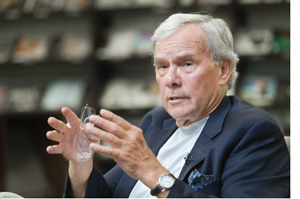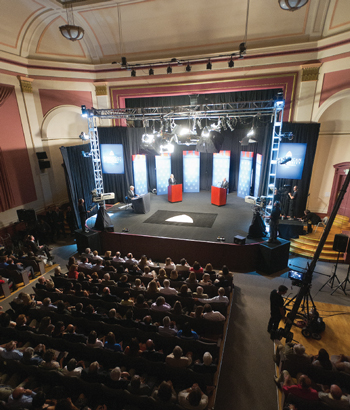The sleepy campus of Dominican University in San Rafael was buzzing on the second Tuesday in October. Reporters and television trucks clogged streets that had been closed to traffic, preparing for the final debate in Jerry Brown and Meg Whitman’s contentious race to become governor of California.
By late afternoon, hundreds of demonstrators had gathered behind police barricades across from Angelico Hall, using megaphones to shout support for their favorite candidate.
Well-dressed debate-goers lingered outside the hall in the autumn heat, sipping ice water flavored with lemon, orange and mint as late afternoon light filtered through the yellow leaves of a Japanese maple. Nearby, television personalities clustered on a brightly lit outdoor platform to discuss the coming event.
Eventually the ticketed audience—which included Sen. Dianne Feinstein, Rep. Lynn Woolsey and other local political luminaries—filed into the dim theater. The hum of the crowd quieted as moderator Tom Brokaw limped onstage, dapper in a dark suit despite being on crutches.
“This is kind of a metaphor for California—we’re both broken at the moment,” the former NBC news anchor quipped, explaining that only days before he had injured his ankle at his ranch in Montana. “The difference is, I hope to be repaired by the first of the year.”
For the next hour, Brokaw fired questions at the candidates while an enthusiastic audience chimed in with shouts, laughter and applause.
The event was the most widely broadcast of the gubernatorial election’s three debates. Yet many in Marin did wonder how such a high-profile event came to a small, private university in San Rafael.
The answer to that question starts with a lean brunette named Maureen Keefe, the university’s vice president of external relations. In 2008, Keefe was intrigued by a brief mention in a news report that only a handful of universities had applied to host vice presidential debates.
“At the time I thought, ‘wouldn’t it be great to have a political debate here at Dominican,’” she says. “Our students so represent the overall demography of the state that this is a natural place for it.”
As Keefe investigated the idea, she learned that hosting a gubernatorial debate was a very realistic option. Compared to presidential debates, these are almost grassroots affairs. Anyone can hold one if both the candidates and the media agree to show up.
To that end, Keefe was referred to Cindy Myers, who was the senior media adviser for the 2008 Democratic National Convention. Myers recommended they add Phil Alongi to the project. As the former executive producer for NBC News special events, Alongi had retired in 2009 to form his own media production company and was ideally situated to arrange media coverage of the incipient event.
 From the time that he was suggested, the cards quickly fell into place. Myers called Alongi and reached him on his cell phone while he was fulfilling one last commitment for NBC—covering the Olympics. He was working alongside his longtime friend and colleague Tom Brokaw, who also happened to be Dominican’s top choice for moderator. Brokaw agreed to participate on the spot.
From the time that he was suggested, the cards quickly fell into place. Myers called Alongi and reached him on his cell phone while he was fulfilling one last commitment for NBC—covering the Olympics. He was working alongside his longtime friend and colleague Tom Brokaw, who also happened to be Dominican’s top choice for moderator. Brokaw agreed to participate on the spot.
“And just like that, we had our team,” Keefe says.
“If there’s a can-do attitude then there’s no reason not to move forward,” Alongi says, describing his own enthusiasm for the project. “Dominican may be small, but if it was an unknown, that’s no longer the case.”
NBC agreed to cover the event very early on, Alongi says. Other media outlets came aboard. Ultimately dozens of news organizations attended the debate, from the New York Times to NPR to Fox News.
The team then had to wait until June’s primary elections were over to ask the winning candidates if they would attend. Formal invitations were sent to Brown and Whitman by FedEx on the day after the primary, and both candidates responded promptly and affirmatively.
From that moment in early June until the last TV crew packed up their cameras and went home the night of October 12, the staff at Dominican spent much of their time attending to the myriad details required to put on such an event.
“I wouldn’t say that there were hitches, but there definitely were challenges,” Keefe says.
These challenges ranged from planning parking for the influx of visitors to accommodating the technical needs of more than 200 reporters and TV crews. The particulars sometimes seemed obscure—at the request of NBC, volunteers were stationed at each fire alarm to make sure no prankster interrupted the debate.
Meetings were held with neighbors to seek their support and patience, as well with local law enforcement officials, who worried about how demonstrators might behave and decided to close off several blocks of Grand Avenue for security purposes.
In order to guarantee fair access to the debate, Dominican held a lottery for the free tickets. Nearly 4,000 students and members of the public competed for fewer than 800 seats.
As well as attending to the media and the community, Dominican approached the event as a unique lesson for its students. Involvement ranged from having the Green MBA students improve the events environmental impact to a multidisciplinary class with Brokaw to volunteering.
“This is a marvelous chance for us to provide an educational opportunity for our students,” says Dominican President Joseph Fink, who started his career in academia by earning a Ph.D. in American history and is retiring next year after 23 years at the school.
“To see a political debate of this type available on our campus is rewarding for me personally, but it’s also rewarding because it’s part of the fulfillment of the mission of the university,” he says.
After months of planning, the affair went smoothly. Visitors appeared unperturbed by the heat or having to navigate multiple security barricades and ticket checkpoints. They were happy to mingle and chat while waiting for the debate to start, ignoring the shouts of the demonstrators.
As the audience began to shuffle up the steps of Angelico Hall, a man turned to his gray-bearded companion and said, “This is incredible. It really is an event.”
Recap with Tom Brokaw
 In regard to candidates answering with specifics, how did this compare with other debates you have moderated? Actually, I thought they were surprisingly responsive to the questions and quite specific in their answers.
In regard to candidates answering with specifics, how did this compare with other debates you have moderated? Actually, I thought they were surprisingly responsive to the questions and quite specific in their answers.
Granted, there was stimulating verbal sparring, but did either candidate articulate attainable solutions to California’s problems? Personally, I thought they could have used my final question regarding the structural flaws of California governing to get at big issues of reform more effectively.
From your vantage point as moderator, did either candidate win the debate? I never declare a winner or loser; it’s up to the viewers.
How will this gubernatorial contest play out on the national political scene? California’s governor’s race is the most important in the country because of the state’s powerful influences and because of the great contrast between the candidates.
What were Jerry Brown’s best and worst moments? Meg Whitman’s best and worst moments? Again, I just make the pitches; I don’t call balls and strikes.
Do you have any final thoughts? I was encouraged they told voters there would be pain and sacrifice ahead. The near- and long-term future will require all Californians to pull on the oars or the ship of state will sink. I thought they both played well to their constituencies. The question is, did either pull any voters across the line? — Jim Wood
By the Numbers
2 The number of venues on campus where the debate was watched: Angelico and Caleruega Dining Hall.
5 The number of student and community focus groups organized to debate the debate at Guzman Hall.
8 The number of NBC Bay Area cameras being used in Angelico Hall for the debate.
34 The number of additional guards Barbier Security added to its force for the debate.
53 In feet, the length of the NBC Bay Area television production truck parked on Acacia Street.
60 In minutes, the length of the debate.
70 In feet, the height of the AT&T cell phone tower temporarily erected for the debate.
123 The number of people who volunteered at Dominican to help with the debate.
201 Media credential requests received for the debate as of October 7.
422 The number of parking spaces on the Dominican campus.
750 The number of available seats in Angelico Hall for the live debate.
1,287 The number of entries received on the first day of the September 7 Dominican debate ticket lottery.
2,234 The total number of students enrolled at Dominican this fall, a school record.
3,745 The total number of entries in the Dominican debate ticket lottery when it closed on September 23.


